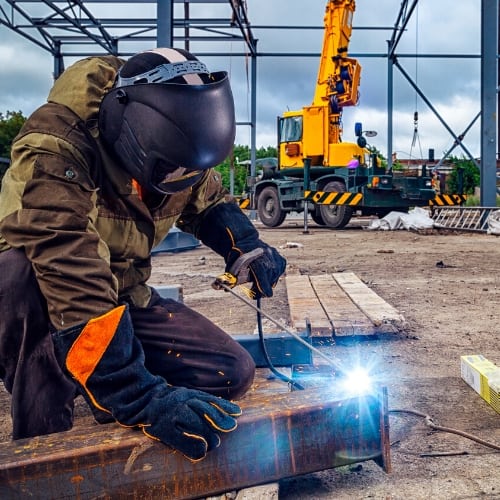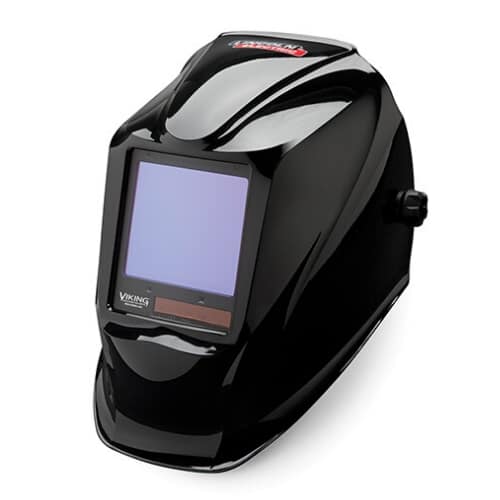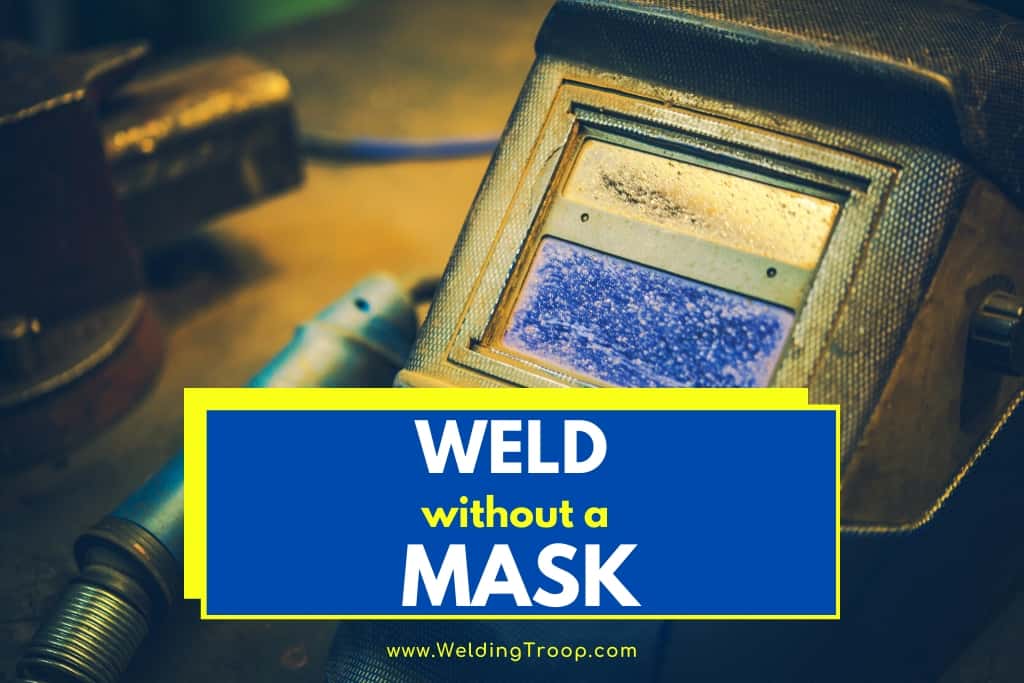Plenty of people weld without a mask, but it is a controversial practice. The existence of welding masks and the fact that they are synonymous with welding in the public imagination shows that the job involves some genuine danger and risk to the face.
You can weld without a mask, but should you? The answer is no; you shouldn’t weld without a mask. Welders can suffer from photokeratitis (also known as “welder’s flash”) or can suffer severe burns to the face or eyes, causing permanent blindness in seconds. The convenience of welding without a mask is not worth a lasting disfigurement.
It is easy to sustain an injury while welding, which is why it is considered one of the world’s more dangerous jobs. Read on to learn more about welding masks and why it’s vital to wear one.
Table of Contents
Welding Without a Mask Can Lead to Eye Injuries
The most significant threat that welding without a mask poses is the various risks to the welder’s eyes. Along with exposure to flying particles, noxious fumes, and any spatter from the weld pool, a welder who doesn’t protect their eyes from an arc welding torch becomes subject to a painful and potentially debilitating condition known as photokeratitis. Photokeratitis is known colloquially in welding circles as “welder’s flash” or “arc eye.”
Similar to snow blindness (but more acute, severe, and long-lasting), photokeratitis is the result of serious UV exposure damage to the eye, similar to a sunburn.
In welding, this UV exposure is the result of staring into the bright arc of the welding torch without UV eye protection in the form of a welding mask or goggles.
Related Reading: Does Welding Hurt Your Eyes? How Can You Protect Your Eyes
Welders who regularly expose their eyes to a welding torch without UV protection risk causing cumulative damage to their eyes. Over time, this exposure can lead to permanent blindness. In the short-term, it can result in an agonizing condition that makes any exposure to light painful.
Aside from welder’s flash, welders who weld without a mask are also risking physical injury to their eyes from slag or molten spatter. While these might cause severe burns or scarring on the unprotected face, they can be much more dangerous if they enter the eye itself.
Serious Burns
Welding involves manipulating metals and other materials at very high temperatures. To put it in perspective, human skin is capable of melting at the temperature of boiling water, which is 212 degrees Fahrenheit. A welding torch is capable of heating metals to several times that temperature. In layman’s terms, that means if molten slag lands on your bare face, you’re going to have a bad time.
Not only are burns among the most painful injuries you can sustain, but they’re also among the most dangerous. Severe burns are much more susceptible to painful, invasive secondary infections. Not only can a burn on your face from welding permanently disfigure you, but it can also lead to an infection that could potentially kill you.
There are some careers where suffering minor burns is often part of the job, such as working in a kitchen or bakery. Still, amateur welders need to remember that the temperatures involved in welding are usually much, much higher than those that are used in other kinds of crafts. This means that the risks involved in welding are higher, and welders should take extra care in response to that.

Skin Cancer
The same high-strength UV exposure from a welding torch that can cause arc eye without a welding mask can also cause UV damage to the skin of the face as well. Cumulative exposure to UV radiation from a welding torch that can damage the eyes can also seep into the surface of the skin, leading to melanoma or basal cell carcinoma.
Skin cancers are particularly dangerous because of their ability to spread to other organs of the body and are considered the most common form of cancer in the United States. From a statistical standpoint, getting five or more sunburns doubles your chances of developing melanoma in your lifetime, and using a welding torch without a mask is like exposing your face and eyes to a sunburn every time you do it.
Welding Masks are Required in the Workplace
American workplaces are held to the Occupational Safety and Health Administration (OSHA) standards set forth for safety by the Department of Labor. In most places around the world, similar standards are put into place to make sure that welders are protected on the job by protective equipment.
Along with welding masks or helmets, welders should also suit up with the following protective equipment:
- Welding respirator
- Flame retardant clothing and welding aprons
- Earmuffs
- Insulated boots and gloves
This protective equipment not only protects the welder from physical injuries such as burns or electrocution, but it also protects them from cumulative injury such as UV radiation. Protective equipment can protect welders both from accidents as well as workplace exposures that could cause them health problems in the future.
How to Weld Without a Mask Anyway (And Reasons Why You Might Want To)
It is possible to weld without a full welding mask, but you do so at personal risk. Welding without a welding mask can be accomplished while still protecting the eyes by using welding goggles instead of a full welding mask. These goggles protect the eyes from UV exposure and molten slag or flying particles but leave the rest of the face free.
There are several reasons why a welder might want to risk welding without a full welding mask:
- The welder is experienced enough at welding or familiar enough with the materials at hand that they feel their risk of being burned in the face is minimal.
- The welder is torch welding rather than arc welding. Torch welding does not produce as bright of a flash as an arc welding unit.
- The welder is only doing a single quick tack weld or some other transitory weld, rather than an extended welding session.
Even if a full protective welding mask isn’t used while welding, it is still crucial to protect the eyes every time from both physical damage and UV burns. A welder will likely recover from sunburn to the face caused by an arc welding torch, but not every welder recovers from a bad flash injury to the eyes themselves. It simply isn’t worth the risk of permanent blindness.

When welding with goggles alone rather than a full welding helmet or mask, it’s also imperative to take full cautionary measures to prevent burns to the face. Not only can a facial burn be excruciating and heal slowly, but it can also cause secondary health problems and long-term scarring.
Protecting Your Eyes and Skin Is Vital in Welding
If you want any kind of long-term career in the welding industry without suffering from reduced vision or cancer in your retirement, you’ve got to learn the importance of protective equipment early on.
Rather than being imposed as a way to make welding more uncomfortable, protective equipment is the only thing standing between you and serious injury during a welding project.
Benjamin Franklin famously stated that when it comes to fire safety, “an ounce of prevention is worth a pound of cure.” And this idiom is no less true of welding than it is of any other craft that involves wielding fire. Taking steps to prevent injury is crucial when welding, so make sure to wear a mask!
Recommended Reading
Does Welding Hurt Your Eyes? How Can You Protect Your Eyes
Can Welding Really Cause Sunburn? Effect On Skin and Eyes
Does Welding Cause Cancer? | How to protect yourself while welding

